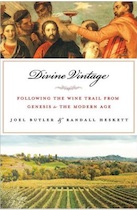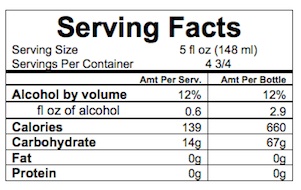|
|
Feds to allow nutrition labels on wine
"How many calories are in a glass of wine? How many carbs? Is there any fat or cholesterol? And come to think about it, how much wine is in a glass?"
I get a lot of wine questions, and more than a small share of them fall into this general category. People want to know whether a glass of red wine will do as much dietary damage as a Quarter Pounder. (Answer: no). Or they hope a glass will make as light a snack as a few stalks of celery. (Well, no to that, too, unless you really load the celery up with Roquefort dressing or pimento cheese).
For many years, though, the wine industry has fought, kicked, screamed and held its breath until it turned blue against any suggestion of the government requiring nutritional or ingredient information through regulation.
Now, though (with a hat tip to The Wine Curmudgeon blog for digging this out), the U.S. Treasury Department's Alcohol and Tobacco Tax and Trade Bureau (TTB) has hit on a working compromise: Under a new rule issued May 28, wineries may optionally place the familiar nutritional analysis label (pictured above) on bottles of wine.
By avoiding a mandatory rule, TTB gets the labeling concept into the marketplace without massive industry resistance and, if it takes off with consumers, commercial pressure will likely make the labels univeral. Some key industry players are apparently pushing for it, The Wine Curmudgeon reports. Diageo North America, for instance, a giant drinks distributor, apparently led an industry coalition in its favor.
My guess is that the industry will wage continued war against ingredient labeling, which opens all sorts of new doors that many would rather keep shut, such as unveiling the use of acidifying or deacidifying materials, coloring compounds and other goodies that might reveal some wines aren't as "natural" as we want to believe.
But this is a good first step, and based on the numbers and frequency of wine nutrition questions that cross my desk, I expect it will be popular.
The new labels may start appearing soon, as TTB has issued a temporary rule spelling out details while regulators write the final rules. While you're waiting, though, here's some overview info from our WineLovers Questionary:
How many servings in a wine bottle?
If you're serving wine with dinner, you can get five generous (5-ounce) pours out of a "fifth" (750 ml) bottle. For a wine tasting, where people are taking smaller sips of several wines, count on at least a dozen 2-ounce tastes, or, if you're really stretching to share a taste of a prized wine with a large group of friends, perhaps 20 tiny tastes of a little over 1 ounce.
How many calories in wine?
Just because wine contains no fat or cholesterol, don't get the idea that you can drink a lot of it without showing the results on your waistline.
The exact calorie content of wine varies depending on both its alcohol and sugar content, so a strong, sweet wine like Port has a much higher calorie load than a dry table wine of normal strength. But you can assume that your 5-ounce glass of dry red or white table wine is likely to have 100 to 125 calories, while a rich dessert wine could go up to 150 calories or more for a smaller 3-ounce glass.
How many carbohydrates in wine?
If you're on a low-carbohydrate diet, you might want to take wine off your bill of fare for the duration.
Wine contains no fat and no protein, but just about all of its not-insignificant calorie content is in the form of carbohydrates and alcohol, which is metabolized much like a carbohydrate.
Wines vary substantially depending on their alcoholic content and whether they have residual sugar, but a 5-ounce glass of dry white table wine may have 1.0 to 1.25 grams of carbohydrates, while a similar portion of red may go up to 2.5 grams, and sweet wines with their high sugar content will have substantially more, up to the range of 10 grams in a 3-ounce serving of a strong dessert wine like Port.
Bear in mind that low-carbohydrate diets may reduce calories, but they do this by adding a frightening level of calories from fat to your daily intake. I suggest a good moderate lifestyle of sensible eating (including wine!) and exercise, and consult your physician for advice if you feel a need to diet.
Fascinating wine history book
 In Divine Vintage: Following the Wine Trail from Genesis to the Modern Age, Master of Wine Joel Butler and bible scholar Randall Heskett explore the influence of wine on human society since the dawn of civilization, examining both the historical record and the arc of Western philosophy as reflected in their reading of biblical texts and other ancient writings about wine.
In Divine Vintage: Following the Wine Trail from Genesis to the Modern Age, Master of Wine Joel Butler and bible scholar Randall Heskett explore the influence of wine on human society since the dawn of civilization, examining both the historical record and the arc of Western philosophy as reflected in their reading of biblical texts and other ancient writings about wine.
This is not a religious book but a cultural examination of how wine has figured in history and how bible stories from Noah's vineyard to Jesus' changing water into wine reflected the evolution of human understanding of wine and spirituality. It's a fascinating book for any wine lover, history buff or spiritually inclined person, and you don't have to be a seminarian or church-goer to enjoy it. It's highly accessible and of interest to anyone who seeks a literate romp through the history of ancient wine.
Order Divine Vintage: Following the Wine Trail from Genesis to the Modern Age from Amazon.com today for $18.87, a 30 percent saving from its $27 list price. The Kindle edition is available at the same link for $11.04.
Talk About Wine Online
If you have questions, comments or ideas to share about today's article or wine in general, you're always welcome to drop by our online WineLovers Discussion Group, the Internet's first and still the most civil online community. To find our forums, click:
http://www.wineloverspage.com/forum/village
Discussions are open for public viewing, but you must register to post. Registration is free and easy; we ask only that you join following our Real Names Real Format system, using your real name in the format "John Doe" or "John D". Anonymous, cryptic or first-name-only registrations are discarded without notice.
Once your registration has been approved, which usually happens quickly, you'll be able to participate in all our online wine, food and travel forums.
To contact me by E-mail, write wine@wineloverspage.com. I'll respond personally to the extent that time and volume permit.
Subscriptions and Administrivia
Unsubscribe:
We're sorry if you must leave us, but simply click the "unsubscribe"
link at the bottom of your Email edition to be instantly removed from the mailing list.
Change address:
The quickest and easiest way to change your Email address is simply to register anew, using the link below. If you are keeping your old address but no longer wish to get the Wine Advisor there, click the unsubscribe link below to take it off our list; if you are closing the mailbox, you needn't take any action, as our system will delete your old address as soon as the mail to your old address starts to "bounce."
Subscribe to this weekly E-letter (free):
http://www.wineloverspage.com/wineadvisor
WineLoversPage.com RSS Feed (free):
http://feeds.feedburner.com/wineloverspage/tzva
Wine Advisor Archives:
http://www.wineloverspage.com/wineadvisor2/archives.php
Sponsorship Opportunities:
For information, E-mail wine@wineloverspage.com





